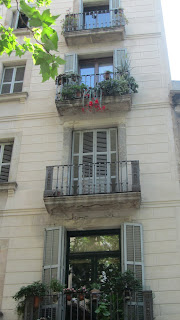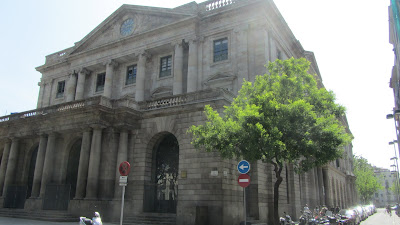We started the Field study with a stop at the Palau de la Musica. The palau is a Catalan Classical music theater which was built in 1901 by the middle class musicians with architect Domènech i Montaner. The building is of modernista style architecture with intricate mosaics and fascinating iron work. It was a place for middle class people to go to the theater and enjoy Catalan music. After the performances, the performers and spectators would travel down the street and relax at the Teatre Lanitc bar.
After the Palau, we visited the Financial Building in the financial district. This large building was not built at the same time that this are of the city was built, therefore, a lot of demolition had to be done to fin in such a large and important building.
We then saw the workshop houses, or specialty guilds, which was the heart of the cities economy. Each house specialized in a certain trade, such as iron, wool, wood working, or shoes, and the entire family, as well as an apprentice, would live and work in the house. Each house has the same basic structure. The ground floor has one large window, where the owner would put the machine and work, so people could see what type of guild it was. This window was the display window. Next to the window was a small door that lead tot he upstairs. The owner of the house would live on the first floor, because there were no elevators in the buildings. As shown in the picture, the first floor had the largest balcony, with each window above it getting smaller and smaller. The top floors were reserved for the servants of the guild and the apprentice. The balconies on the first floor were built as a status symbol, to show everyone that they were successful and of a higher class. The guilds were made of heavy stone, with a wood structure. Each guild had its own saint, which they placed at the front of the house. The oldest guild was the iron guild.
 |
| The largest balcony is on the first floor, while the top floor has the smallest window |
 |
| Large display window with a small door next to it |
We then made it over the the Placa de la llana. This placa was like a modern day Placa Catalunya, but it was for the economy of wool. it was a local neighborhood stock market, where people could see the price of wool, to make business.
Our next destination was the Santa Maria del Mar church that represented Catalan wealth for the area. on our way there, we passed over Carrer Priceza, where they had to reconstruct the street to make it big enough for the princess to leave town when she wanted to. The church was built by the middle class, for the middle class and represented the religion and power of the guild owners. The design is simple and it is connected to God by utilizing natural light. This is where the families were buried.
Our last stop on the field study was Carrer de Canvis Vells, which was the financial district for all the guilds. It financed everyone's guilds and was the center of the economy. This is where the price of all products was determined, and deals were made. It is like the stock market of its time. This is were currency was determined and trading took place. If you were an ally, you had the privileged of dealing with no taxes. It is arrangements like these that were put in place to protect the economy. The building pictured below was the actual stock market building.







No comments:
Post a Comment